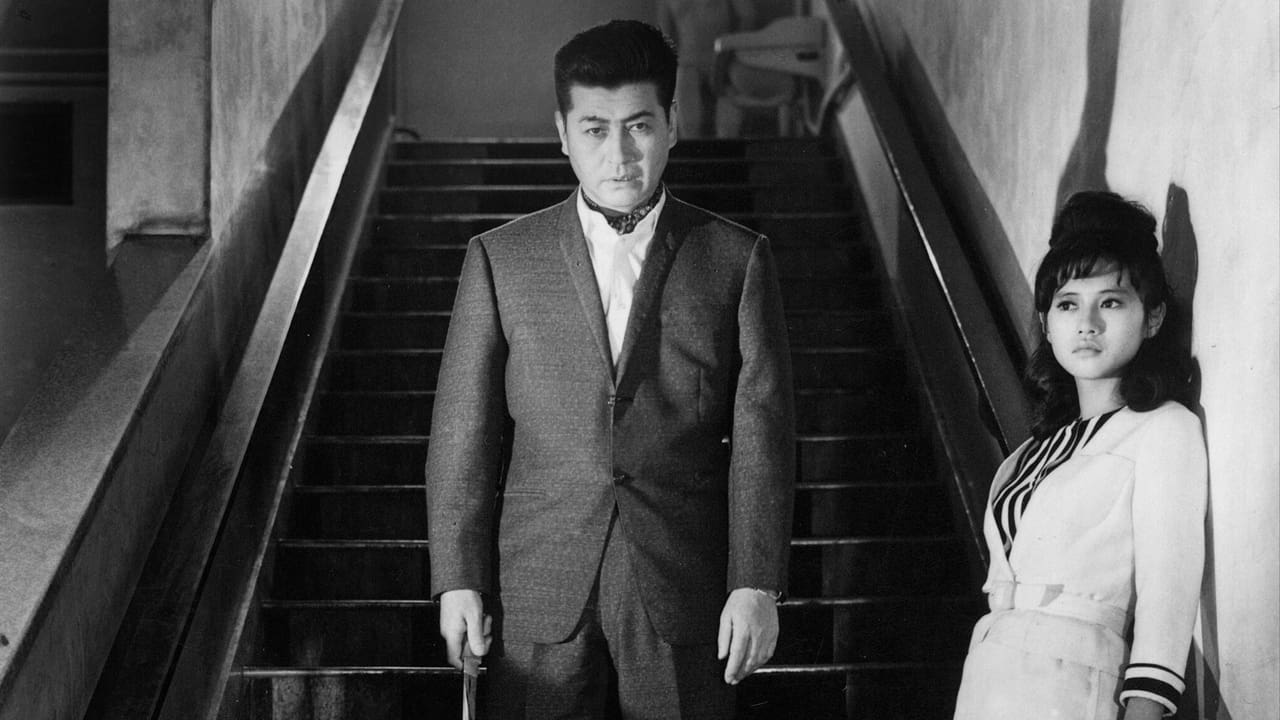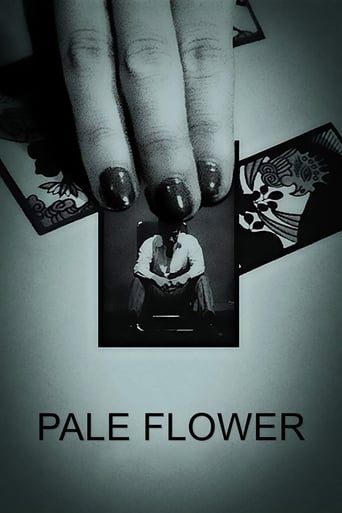

I have absolutely never seen anything like this movie before. You have to see this movie.
... View MoreIt’s sentimental, ridiculously long and only occasionally funny
... View MoreThe film's masterful storytelling did its job. The message was clear. No need to overdo.
... View MoreExcellent and certainly provocative... If nothing else, the film is a real conversation starter.
... View MoreA gangster (Ryo Ikebe) gets released from prison and has to cope with the recent shifts of power between the gangs, while taking care of a thrill-seeking young woman (Mariko Kaga), who got in bad company while gambling.Director Shinoda was influenced by Charles Baudelaire's poetry collection "Les Fleurs du mal" while making the film, an unusual source of input for a film. Shinoda chose the subject of yakuza as he felt the yakuza world is the only place where a Japanese ceremonial structure is sustained.Recently (the first half of 2016) I have seen several Japanese gangster films thanks to Arrow Video and their release of "Gangster VIP" and various other Nikkatsu treasures. This film, from Criterion, is different. A bit darker, perhaps. But most interestingly, it has a very active role for a young woman, being not just a love interest but actually driving the plot. That strikes me as being uncommon, maybe even rare.
... View MoreMasahiro Shinoda's Pale Flower, like many products of the Japanese New Wave movement, is an immaculate mixture of the old and the new. Having studied under Ozu, Shinoda frames the film beautifully, taking influence from American film noir and the French New Wave to tell a story of ageing mobster Muraki (Ryo Ikebe) who is fresh out of prison. However, this is no straight-forward yakuza movie, and the film's loose plot and broodingly charismatic anti-hero are used at every turn to subvert the genre.Having served his time for murder and winning the respect of his peers for keeping his mouth shut, Muraki drifts back into the life he once knew. It's a world of excessive gambling, and it's whilst partaking in an unfathomable game involving black chips that he meets the mysterious Saeko (Mariko Kaga), a beautiful girl with an unhealthy thirst for excitement. He is told that she comes every night and loses all of her money, only to come back the next day for more. Muraki is instantly drawn to her, and the two embark on an equally destructive, but not physical, relationship.With his sharp suits, handsome face, perfect hair and nigh-on permanent black sunglasses, Muraki is the epitome of New Wave cool. But Pale Flower is a more than just an exercise in style. Like Alain Delon's character in Jean-Pierre Melville's Le Samourai, Muraki is a creature of violence stuck in an existential void. Loyal to his yakuza boss for seemingly no other reason than habit, he is constantly restless and bored. Saeko fiercely sparks his interest; as she embarks in a high speed car race with a man she's never met just for the thrill, Muraki watches her, hypnotised and confused.Though we see her laugh orgasmically at the cheap thrills life can offer and talk about her desire to try heroin, there is little revealed about Saeko's inner thoughts and background. Muraki is drawn to her perhaps because she shares his disconnection with the structure of modern life, a common theme in the Japanese New Wave. Though the film is, for the most part, moody and intense, shrouded in shadows and cigarette smoke, Shinoda doesn't neglect to include some black humour. A running joke involving a severed fingers adds a nihilistic quality to the film, leading to a bleak ending that is powerfully fitting.www.the-wrath-of-blog.blogspot.com
... View MoreMuraki is a middle aged yakuza fresh out of jail for murder. Played to perfection by Ryô Ikebe, he's quiet, disciplined, smokes his cigarettes with style, sports a smart suit and a Johnny Bravo haircut. When a woman from a past affair (Chisako Hara) desperately pleads for his love, he shows no interest in yielding. If anything, he seems almost embarrassed by her need of affection. His mind is only preoccupied by a sense of duty toward his gang and some casual betting. Enter Saeko (Mariko Kaga), a beautiful, young girl with the face of a doll and big, daring eyes. She has the look of someone who has nothing to lose. A wealthy, spoiled brat, a nihilist bored with life, she kills time by gambling away her money. Muraki is immediately drawn to her. At first, he's flattered by her attention, but he soon discovers he's too decent and safe for her, not quite extreme or dangerous enough. His pride is wounded, yet he becomes addicted to her youthful foolishness and decadence. Doom is around the corner.Everything about this film is superbly elegant: the acting, the art direction and black-and-white photography, the avant-garde music composed by Toru Takemitsu, the man responsible for the soundtrack of any number of Japanese classics, including Teshigahara's 'Woman in the Dunes', Kurosawa's 'Ran' and Imamura's 'Black Rain'. Directed by Masahiro Shinoda, 'Pale Flower' belongs in the pantheon of great films noirs alongside the likes of 'The Big Sleep' and 'The Postman Always Rings Twice'.***** Spoilers ***** Part of what's most interesting about the relationship between Muraki and Saeko is that it is so Platonic. There's no sign of sexual contact between them. Muraki wants her physically, yet fails to have her. It's a kind of impotence that he experiences. In turn, he becomes more of a protective father figure. After all, Muraki's probably over twice her age. (When they made the film, the actor was 47 and the actress 21.) So there's a sexual tension, an Electra complex (like the Oedipus complex, with the male and female roles reversed). But she saves herself for Yoh, a younger, wilder, more exotic yakuza and this drives Muraki crazy. (This reminds me of Nabokov's 'Lolita', published only a few years earlier.) By the end, a despondent Muraki volunteers to take down the boss of a rival gang, knowing well that this will put him back in prison. But he accepts to do it because he hopes it will excite and impress Saeko. He is sacrificing himself for her pleasure. When he thrusts his knife into the body of his victim at the restaurant, he's projecting onto the act of murder the violence of his frustrated desire for her. Fascinated, she watches from a distance. However, we later learn that Yoh has killed her in an act of passion. So it is Yoh who actually penetrates her with a knife (obviously, a phallic symbol). Muraki has been one-upped again. He has come up with a concept that Yoh ultimately takes to the next level. Saeko's relationship with Muraki remains ideal, while with Yoh it is carnal.Similarly, Muraki is tormented by the prospect of Saeko doing drugs with Yoh, partly because he wants to protect her as a father figure, but also because that could involve Yoh penetrating her with a needle (another phallic symbol).
... View MoreRyo Ikebe is perfect as the super-cool, sharply dressed ex-con who willingly seals his own fate despite his obvious intelligence and powers of perception. His body language is crisp and economical and his life experience is etched into his face. He is the Japanese doppleganger of the under-appreciated (except by Tarrantino) American actor Robert Forster. This is actually worthy of a remake starring Forster but I heavily doubt if any filmmaker can recreate the style and panache that Mr. Shinoda injected into every shot of the astonishing cinematography. In an interview on the DVD extra, he says that nihilism was his main theme but it's a quiet, shadow-covered nihilism, not explosive and bombastic. There are very few scenes of violence; action is not the show here. The heart of the film is the undefinable relationship between the adrenaline-loving rich girl and the yakuza hit man. Shinoda likens his position in life as the embodiment of post-war Japan caught between the Soviet Union and the USA. The climactic hit is brilliantly choreographed, shot and scored. Certain elements of Pale Flower evoked memories of The Face of Another, a totally different type of film that also explored the existential subjects of solitude, isolation and alienation.
... View More